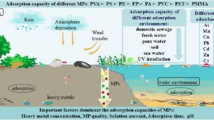Abstract
The Langmuir equation has been widely used for description of the adsorption characteristics in different solid–liquid systems, although it was originally advanced for adsorption of gas molecules on a planar surface. In this paper, the applicability of the Langmuir equation was discussed when it is modified or extended to describe sorption on heterogeneous surfaces such as soils or soil components. The sorption of Cu(II) by loess was investigated experimentally with sediment concentration ranging from 10 to 100 kg/m3, and copper concentration from 64.80 to 7499 mg/l. The measured results were found well fitted with the nonlinear Langmuir isotherm in form, but for the loess with high carbonate content, the Cu precipitation becomes the primary mechanism instead of the original adsorption in the ordinary cases with low carbonate content. Thus, the parameters identified from the same Langmuir form would be essentially different in their physical meanings comparing with those in the conventional Langmuir equation. Using the MINTEQA model, copper precipitation was calculated and the implications of parameters in Langmuir equation were interpreted. Both the `sorption coefficient' and the `sorption maximum' in the Langmuir equation for copper precipitation are very close to those for copper sorption, but the `sorption coefficient' for copper precipitation is greater than that for copper sorption and oppositely for the `sorption maximum', which explains why precipitation dominates the sorption process.
Similar content being viewed by others
References
Allison, J. D., D. S. Brown & K. J. Novo-Gradac, 1991. Minteqa2/ prodefa2, a Geochemical Assessment Model for Environmental Systems: version 3.0 User's Manual, Environmental Research Laboratory Office of Research and Development. U.S. Environmental Protection Agency.
Elprince, A. M. & G. Sposito, 1981. Thermodynamic derivation of equations of the Langmuir type for ion equilibria in soils. Soil Sci. Soc. Am. J. 45: 1077-1080.
Griffin, R. A. & A. K. Au, 1977. Lead adsorption by montmorillonite using a competitive Langmuir equation. Soil Sci. Soc. Am. J. 41: 880-882.
Harter, R. D. & D. E. Baker, 1977. Applications and misapplications of the Langmuir equation to soil adsorption phenomena. Soil Sci. Soc. Am. J. 41: 1077-1080.
Harter, R. D. & G. Smith, 1981. Langmuir equation and alternate methods of studying 'adsorption' reactions in soils. In Dowdy R. H., et al. (ed.), Chemistry in the Soil Environment. Spec. Publ. No. 40. Am. Soc. Of Agron., Madison, WI: 167-182.
Hendrickson, L. L. & R. B. Cory, 1981. Effect of equilibrium metal concentrations on apparent selectivity coefficients of soil complexes. Soil Sci. 131: 163-171.
Jain, C. K. & D. Ram, 1996. Adsorption of lead and zinc on bed sediments of the River Kali. Wat. Res. l31: 154-162.
James, P. M. & E. A Jenne, 1991. Experimental investigation and review of the "solids concentration' effect in adsorption studies. Environ. Sci. Technol. 25: 2082-2087.
Lan Q. D., A. S. Bassi & J. X. Zhu et al., 2001. A modified Langmuir model for the prediction of the effect of ionic strength on the equilibrium characteristics of protein adsorption onto ion exchange/affinity adsorbents. Chem. Eng. J. 81: 179-186.
Mellah, A. & S. Chegrouche, 1997. The removal of zinc from aqueous solutions by natural bentonite. Wat. Res. 31: 621-629.
Misak N. Z., 2000. Some aspects of the application of adsorption isotherms to ion exchange reactions. React. Funct. Polym. 43: 153-164.
Namasivayam, C. & K. Panganathan, 1995. Removal of Cd(II) from wastewater by adsorption on 'waste' Fe(III)/Cr(III) hydroxide. Wat. Res. 29: 1737-1744.
Sparks, D. L., 1995. Environmental Soil Chemistry. Academic Press, New York.
Veith, J. A. & G. Sposito, 1977. On the use of Langmuir equation in the interpretation of 'adsorption' phenomena. Soil Sci. Soc. Am. J. 41: 697-702.
Zhao, P. L., X. C. Shen & J. Xia et al., 1998. Sediment Effect onWater Quality of Yellow River and Water Pollution Control on the Key River Sections (in Chinese). Yellow River Water Resource Press, Zhengzhou: 23-30.
Zhou, D. H., X. H. Li & F. L. Xu et al, 1996. Application of mass-action model for describing the adsorption characteristics of heavy metals on soils. Acta Sci. Circumstantiae (in Chinese). 16: 425-430.
Author information
Authors and Affiliations
Rights and permissions
About this article
Cite this article
Jinren, N., Weiling, S. Applicability of the Langmuir equation to copper sorption by loess with high carbonate content. Hydrobiologia 494, 259–263 (2003). https://doi.org/10.1023/A:1025439004499
Issue Date:
DOI: https://doi.org/10.1023/A:1025439004499




